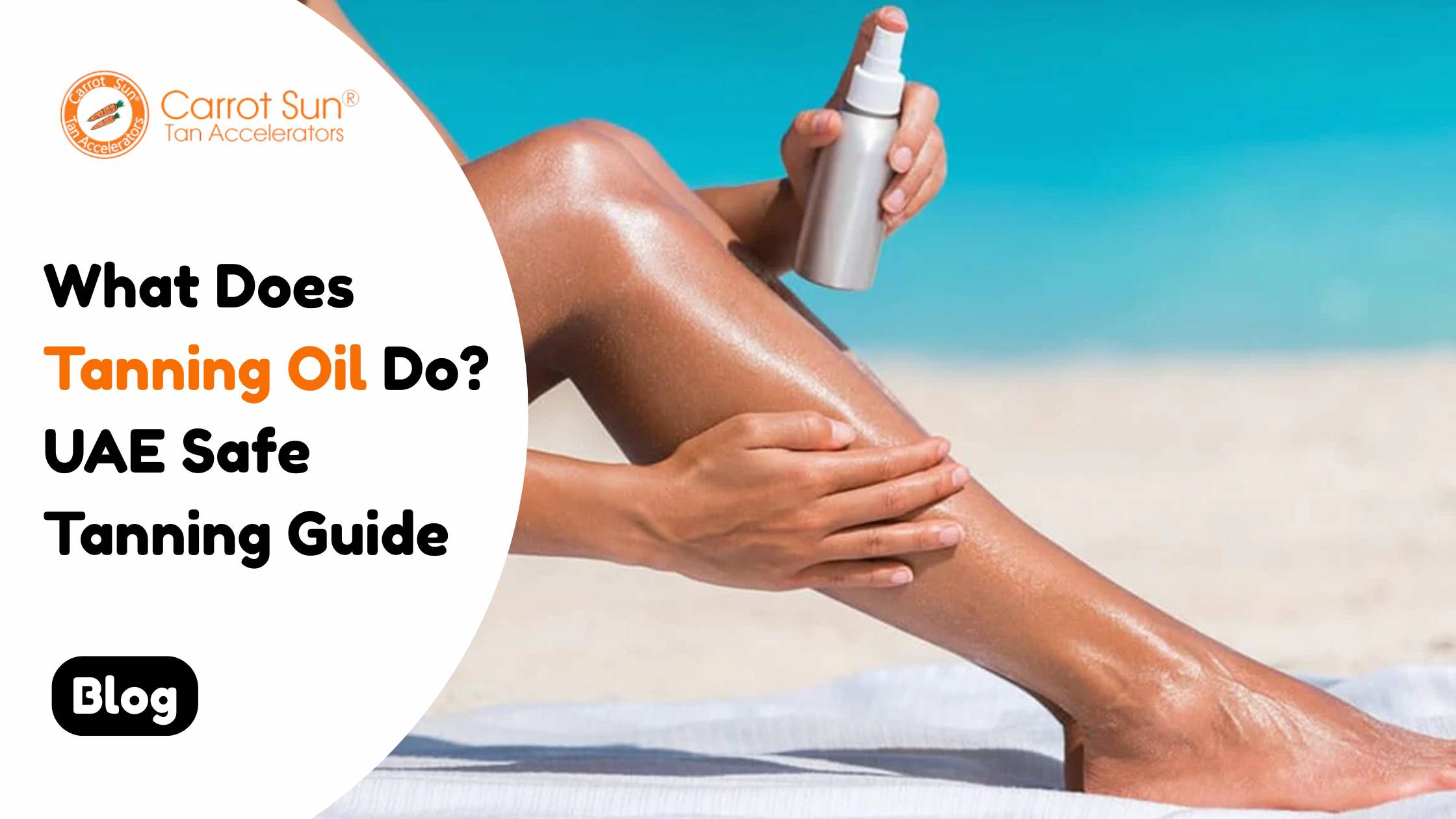
What Does Tanning Oil Do? UAE Safe Tanning Guide
If you’ve ever wondered why some people get that perfect golden glow while others end up with patchy, uneven tans, the answer often lies in one product: tanning oil. Living in the UAE means year-round sunshine, but knowing how to tan safely while achieving that deep bronze color requires the right approach. This guide explains exactly what tanning oil does, how it works in UAE’s intense climate, and how to use it without damaging your skin.
How Tanning Oil Actually Works
Tanning oil accelerates melanin production by attracting UV rays to your skin’s surface and keeping it moisturized during sun exposure. This results in a faster, deeper, and more even tan compared to tanning without any product.
When you apply tanning oil, it creates a thin reflective layer on your skin. This layer doesn’t block UV rays—instead, it helps them penetrate more efficiently into the epidermis where melanin cells live. The oil also prevents your skin from drying out, which is crucial because dry skin doesn’t tan well and often peels before you can enjoy your glow.
What Happens When Tanning Oil Meets UV Rays
UV radiation triggers your body’s natural defense mechanism: producing melanin. Tanning oils containing specific ingredients like L-Tyrosine and beta-carotene give your melanocytes (melanin-producing cells) the building blocks they need to work faster. The result? You achieve in 30 minutes what might otherwise take an hour or more.
How Oils Stimulate Melanin Production
Quality tanning oils contain amino acids and vitamins that directly support melanin synthesis. Carrot Sun Tanning Oil includes L-Tyrosine, which is scientifically proven to enhance melanin production. Beta-carotene from carrot oil gives your tan that golden undertone rather than an orange or red burn.
Key Ingredients Found in Effective Tanning Oils
The best tanning oils for UAE weather combine tanning accelerators with deep moisturizers:
Carrot Oil: Rich in beta-carotene and vitamins A and E for golden color and skin protection
L-Tyrosine: An amino acid that directly boosts melanin without harsh chemicals
Coconut Oil: Provides lasting hydration in dry desert air
Almond Oil: Softens skin and prevents flaking
Wheat Germ Oil: Packed with vitamin E for antioxidant protection
You’ll find these ingredients in premium products like Carrot Sun tanning sprays and creams designed specifically for intense sun exposure.
Will Tanning Oil Make You Darker?
Yes, tanning oil makes you tan darker and faster by increasing melanin production and UV absorption. However, the depth of your tan depends on your natural skin type, sun exposure time, and whether you use SPF protection underneath.
Science Behind Melanin Activation
Your skin’s darkness after sun exposure comes from melanin migrating to the surface. Tanning oils speed this up by providing your skin with the nutrients it needs and keeping the skin barrier intact. Without moisture, your tan develops unevenly and fades quickly through peeling.
Why UAE’s Strong Sun Accelerates the Effect
The UAE has one of the highest UV indexes globally, often reaching 10+ during summer months. This means tanning oils work exceptionally well here—sometimes too well if you’re not careful. What takes 45 minutes in cooler climates might only need 20 minutes in Dubai or Abu Dhabi.
Check out our guide on safe tanning practices for specific timing recommendations.
How to Avoid Over-Tanning and Burns
Start with just 15-20 minutes for your first session. Apply SPF 30 sunscreen first, then layer tanning oil on top. Avoid tanning between 11 AM and 3 PM when UV is strongest. Flip every 10-15 minutes for even coverage. Stay hydrated—drink water before, during, and after. Use after-sun lotion immediately after to lock in color.
Is It Better to Tan Without Tanning Oil?
No, tanning without oil typically results in drier, more uneven tans that fade faster and increase your risk of peeling. Tanning oils provide essential moisture and help develop deeper, longer-lasting color when used correctly with sun protection.
Natural Tanning vs Enhanced Tanning
Tanning without any product means exposing dry skin to UV rays. In UAE’s desert climate, this dries your skin further, leading to uneven color with dark patches, flaky peeling skin, shorter-lasting tans, and increased fine lines from dehydration.
Enhanced tanning with quality oils means nourished skin that tans evenly and retains its glow for weeks. The moisturizing properties of tanning oils make all the difference in hot climates.
Balancing Hydration, SPF, and Results
The smartest approach combines three layers: SPF sunscreen as your base protection, tanning oil for color acceleration and moisture, and after-sun care to maintain hydration.
This method gives you the best of everything: protection, beautiful color, and healthy skin. Learn more about tanning oil versus tanning cream options to find what works for your skin type.
What Does Tanning Oil Do to Pale Skin?
Tanning oil helps pale skin develop a gradual, golden tan while preventing burns—but only when paired with appropriate SPF and shorter sun exposure times. Fair skin can absolutely tan safely in the UAE with the right products and approach.
Tips for Fair Complexions Under UAE Sun
If you have naturally light skin, your melanocytes produce less melanin, so you burn more easily. Start with SPF 30-50 underneath your tanning oil. Limit initial sessions to 10-15 minutes maximum. Choose gentle formulas like Papaya Tanning Cream designed for sensitive skin. Tan only before 10 AM or after 4 PM. Wait 48 hours between tanning sessions initially.
Using SPF-Based Tanning Oils Safely
Some tanning oils now include light SPF protection. While these are better than nothing, dermatologists recommend applying dedicated sunscreen first, then your tanning oil. This dual-layer approach gives fair skin the protection it needs while still allowing gradual color development.
Gradual Tanning and Skincare Aftercare
Pale skin shows results more dramatically, so patience pays off. After each session, apply aloe vera gel or cooling after-sun lotion. Use a rich moisturizer before bed. Avoid hot showers that strip oils from skin. Exfoliate gently once per week, not immediately after tanning.
Consider reading our complete guide for sensitive skin tanning to understand which products work best for your complexion.
Is Tanning with Oil Bad for You?
Tanning with oil is not inherently bad when done responsibly with sun protection and moderation. Quality tanning oils actually protect your skin through antioxidants and hydration—the danger comes from overexposure to UV rays, regardless of what products you use.
Common Myths Debunked
Myth: Tanning oil fries your skin like cooking oil
Reality: Modern tanning oils are scientifically formulated skincare products with vitamins, antioxidants, and moisturizers that support skin health.
Myth: All tanning oils clog pores
Reality: Non-comedogenic oils like Carrot Sun formulas are specifically designed not to block pores.
Myth: Using oil means you don’t need sunscreen
Reality: Tanning oils accelerate tanning but rarely provide adequate UV protection. Always use SPF underneath.
Dermatologist-Approved Safety Guidelines
Skin experts recommend never tanning more than 3-4 times per week. Always pair tanning oil with SPF 15-30 minimum. Choose oils with antioxidants like vitamins A, C, and E. Avoid tanning if you’re on photosensitizing medications. Get annual skin checks if you tan regularly.
Choosing Non-Comedogenic and Antioxidant Oils
Look for labels that say non-comedogenic, dermatologist-tested, free from mineral oils and parabens, and rich in vitamins A and E. Carrot Sun product range meets all these criteria with natural ingredients that nourish rather than damage skin.
Is Tanning Oil Worse Than No Sunscreen?
Tanning oil alone offers little to no UV protection, making it potentially harmful if used without sunscreen. The oil intensifies UV exposure, which increases burn risk—always use sunscreen as your primary protection and tanning oil as an enhancement layer.
Understanding SPF Levels in Oils
Most traditional tanning oils have SPF 0-4, which provides virtually no UV protection. Some newer formulas include SPF 8-15, which helps but isn’t sufficient for UAE’s intense sun. For safe tanning, apply SPF 30 first, wait 15 minutes for absorption, then apply your tanning oil on top.
Why Pairing Sunscreen + Oil Is Crucial
Think of it this way: sunscreen is your shield, tanning oil is your enhancer. The Carrot Sun 30 SPF Sunscreen provides protection while the tanning oil on top helps you develop color safely. This combination prevents burns while still allowing melanin production.
Using oil without sunscreen in UAE’s climate is asking for second-degree burns, permanent sun damage, premature aging and wrinkles, and increased skin cancer risk.
Do You Tan Better Wet or Dry?
You tan faster when your skin is wet because water droplets reflect and magnify UV rays, increasing exposure intensity. However, this also increases burn risk and can lead to uneven tanning—plus, water washes away your tanning oil and sunscreen.
How Moisture and Reflection Affect Tanning Intensity
Water acts like tiny magnifying glasses on your skin. While this accelerates tanning, it’s unpredictable and dangerous. You might get intense color on your shoulders while your torso stays pale simply based on where water sits on your body.
Expert Safety Tips for Water-Based Tanning
If you’re tanning while swimming, use water-resistant tanning oil formulas like Watermelon Tanning Spray. Reapply both sunscreen and oil every time you exit the water. Pat dry rather than rubbing to preserve your products. Expect to use 2-3x more product than dry tanning. Be extra vigilant about timing—wet tanning can burn you in half the usual time.
For the most even, controllable tan, stick to dry tanning on a lounger and save swimming for after your tanning session.
Safe Tanning Practices in the UAE
The safest tanning times in UAE are before 10 AM and after 4 PM when UV index drops below extreme levels. Combine smart timing with proper products, hydration, and skin monitoring for optimal results without damage.
Ideal Timings for Tanning
Best tanning hours in UAE:
7:00-10:00 AM: Moderate UV, gentle warmth
4:00-6:00 PM: Falling UV levels, comfortable temperature
Avoid tanning between:
11:00 AM-3:00 PM: UV index 10+, extreme burn risk
Monthly variations:
Summer (June-September): UV extremely high, limit sessions to 15-20 minutes
Winter (November-March): More forgiving, can extend to 30-40 minutes
Hydration and After-Sun Care Routines
Before sun: Drink 500ml water. Exfoliate gently the day before, not same day. Apply sunscreen and let absorb 15 minutes. Apply tanning oil evenly.
During sun: Sip water every 15 minutes. Flip positions for even coverage. Monitor skin for redness.
After sun: Shower with lukewarm water. Pat dry gently. Apply aloe vera gel or after-sun lotion. Follow with rich moisturizer. Drink extra water.
Learn more about complete sun care routines for healthy skin in UAE.
Recommended Products and Protective Layering
For dry skin: Cocoa-Butter Tanning Cream + SPF 30
For sensitive skin: Papaya Tanning Pack + SPF 50
For fast tanning: Carrot Tanning Spray + SPF 30
For face: Lightweight SPF 50 facial sunscreen (apply tanning oil only below neckline)





Add comment